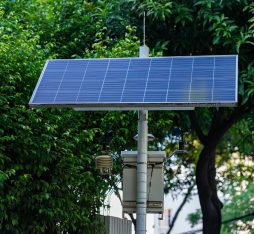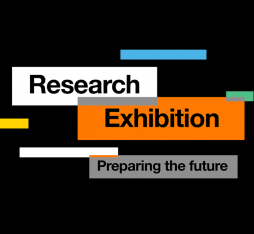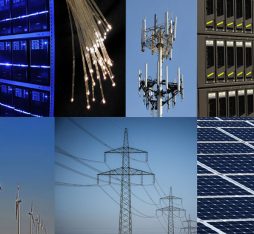In these troubled times where global warming, pandemics, and war make the headlines, energy and how it is produced, supplied, and consumed is likely to shape our future. The energy footprint has become one major concern in most sectors of the industry. Communication networks are no exception and Orange is one of those global operators that target energy savings for several years and counting.
What if networks were able to consider energy as an intel that would contribute to not only optimize their energy consumption, but also improve resource usage and traffic forwarding efficiency?
Energy is at the core of future, optimized networks. So that digital communications won’t take the heat anymore.
This article discusses an approach to energy-aware networking.
It explores some of the techniques that can help communication networks achieve energy savings, starting with sensor networks. It then discusses how other communication networks like fixed or mobile infrastructures can enforce energy-aware traffic forwarding policies, including at the Internet scale. It finally highlights some of Orange Innovation’s activities in that very timely area.
What is energy-aware-networking?
Energy-aware networking can be defined as the set of techniques that exploit energy-related information to assist either the route computation or the traffic forwarding decision-making processes, or both.
Energy-related information includes (but is not necessarily limited to) the amount of energy that is left in a battery-powered sensor, the amount of energy that has been consumed by a network equipment over a given period of time, the amount of energy that has been produced by an equipment to supply power to network devices (power supply systems, battery cells, inverters, etc.), or the energy it takes to send a bit of information as part of a duty cycle management policy that may be enforced by the radio components of a sensor, for example.
Networked sensors paved the way to energy-aware networking.
Most of sensor technologies are energy constrained. When networked, sensors whose energy resources are degraded (low battery) may jeopardize traffic forwarding. The selection and establishment of a path within a (wireless) sensor network may therefore result from a computation that considers energy-related information as one input. One iconic example of energy-aware route computation relies upon a routing protocol that has been designed for such sensor networks.
The Routing Protocol for Low power and lossy networks (RPL, [RPL2014]) computes mathematical structures called (Destination-Oriented) Directed Acyclic Graphs (DODAGs, Figure 1) that are meant to minimize the risk of routing loops. These tree structures direct traffic from “child” sensors to “parents” (e.g., actuators that send commands to a set of sensors).
The corresponding forwarding paths are chosen so that their cost is minimized according to the Objective Function (OF) [RFC6552] that defines the route computation objectives based upon one or several decision criteria, including energy considerations.
RPL can thus use energy-related information (like the nature of the power source, the amount of energy that is left in a battery-powered sensor, the energy footprint of a forwarding path from a sensor o an actuator, etc.) as a metric for path computation purposes. In essence, this information consists of the Node Energy object metric ([RFC6551]).
This object includes a 2-bit encoded field that is used to define three types of power sources (“powered”, “battery” and “scavenger”). The value of such field is usually sufficient for many applications to address the energy-aware routing computation objectives.
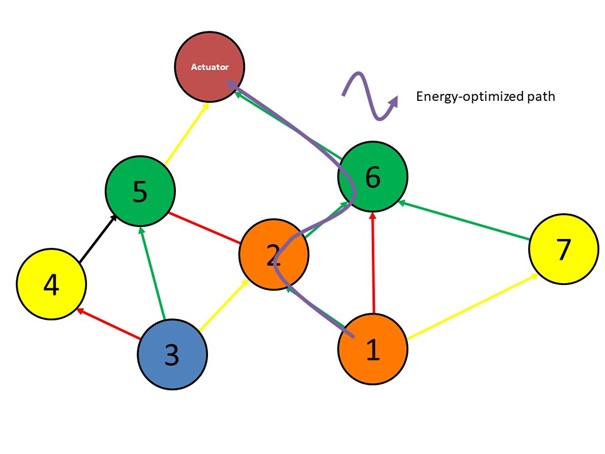
Figure 1: Energy-optimized path within a Destination-Oriented DAG (DODAG) structure. Arrow colors between networked sensors reflect the values of the Node Energy object, from green (“battery high”) to red (“battery low”).
In addition, energy-aware route computation in sensor networks can also rely upon the Energy Estimation (E_E) field of the Node Energy object. E_E is a parameter that provides additional intel to route computation machineries, such as the amount of energy resources that are left in a sensor.
For example, E_E can be defined as:
- The ratio between the current expected battery lifetime and the desired minimum lifetime of a battery-powered device.
- The ratio between the total amount of the energy that is stored in the device and the target remaining energy (assuming the said device can measure its power consumption).
Energy-aware path computation would then search for the max(min(E_E)). Standards, prototypes, and even operational deployments of energy-aware sensor networks have been released for a few years.
The energy-related information used by a sensor to make a forwarding decision can thus be used to enforce energy-aware networking policies motivated by various objectives, such as “only transmit what is strictly necessary”. As such, packet header compression techniques are instrumental in very constrained sensor networking environments where energy savings can be accomplished.
Compressing a byte of information by means of header compression can consume up to 500 times less energy than if this byte were transmitted in its entirety over the network [ACKLIO2022].
But what about other communication networks?
Energy savings can be achieved by any communication network
The massive deployment of the Internet over the past three decades and the successive generations of mobile networks have been largely motivated by the need to accommodate significant traffic growth.
Quite intuitively, the more traffic to process, the more power is consumed by a network equipment [CHABAREK2008].
This traffic growth inevitably aggravates the energy consumed by networks (whatever their nature – cellular, wireless, IP, optical, etc.), cloud infrastructures and terminal devices, regardless of their technology.
From this perspective, the 2021 report of the International Energy Agency (IEA, [IEA2021]) provides several enlightening figures:
- The deployment of data centers, including massively scalable data centers and those used by telco cloud infrastructures led to ~1% of the global electricity demand in 2020, whereas communication networks worldwide consumed 1 to 1.4% of the electricity the same year
- Yet, the energy efficiency has also improved significantly by 10 to 30% in recent years. In addition, current predictions of different origins seem to converge towards 5G networks that would be 10 to 20 times more energy-efficient than 4G networks by 2025-2030
- The introduction of Artificial Intelligence (AI) techniques combined with Machine Learning (ML) has significantly increased the compute demand, which dramatically affected the global energy consumed by Data Centers (+40% per year, [META2021]) of Meta/Facebook premises).
In addition, foreseeable, potentially CPU-intensive and energy-greedy services like those that take advantage of augmented or virtual reality techniques are progressively emerging. With the current Metaverse hype, where avatars of users are expected to live a broad variety of virtual experiences, energy savings may be unlikely considering the DC resources involved but also the need to synchronize users’ actions (movements, transactions, communications) with their avatars’.
Energy-related information should thus be used to fine tune traffic forwarding policies and achieve significant energy savings.
Such information can be manifold: the battery load as already mentioned earlier can be used to compute energy-aware forwarding graphs, but traffic patterns and service usages can also fuel path computation engines. Indeed, traffic volumes vary on a daily or hourly basis, leading to peak hours, consumed bandwidth averages, and close-to-idle periods during which links that are not used are moved to an idle state.
Consumer behaviors inevitably affect the energy consumed by communication networks (let alone their terminal devices). Traffic forwarding and path computation policies can thus be inspired by such behaviors so that, for example, paths that will be used to forward daylight traffic may differ from paths used to carry nightly traffic.
Such intel can thus translate into routing objectives that are forwarded to the participating network resources (switches, routers). They can indeed consist in a set of constraints (e.g., compute and select routes towards a set of destinations that will forward packets between 06:00 AM and 06:00 PM) and metrics (e.g., assign 1 to Gbit/s links, 10 otherwise) that are meaningful for these resources.
In a Path Computation Element (PCE) environment, carrying such objectives and constraints would consist in using a specific PCE object that would be carried in PCReq messages sent by the PCE to the Path Computation Clients (PCC) clients [CONTRACT-ID].
In an IPv6-enabled Segment Routing environment, one could use Binding Segment Identifiers (BSID) to identify energy-aware traffic forwarding policies (Figure 2).
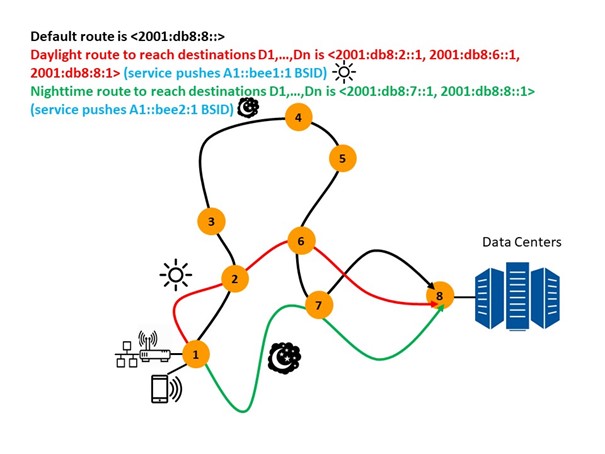
Figure 2: Daytime/Nighttime traffic forwarding can achieve energy savings.
Energy-aware path computation can also be extended at the global Internet scale.
Indeed, the BGP (Border Gateway Protocol) protocol that is used to exchange routes across the networks that compose the global Internet can also be used to reduce power consumption [RAMAN2013].
The approach relies upon the computation of the consumed power to available bandwidth ratio R.
Ratio R is then exchanged between autonomous systems or BGP domains (namely a network operated by an administrative entity like an operator or a service provider) by means of BGP.
Ratio R is computed by summing the energy consumed by all routers of a given BGP domain divided by the number of routers. R’s accuracy can be refined by classifying routers of a BGP domain into different types which are assigned different weights. The resulting consumed energy is divided by the maximum bandwidth available for each egress link that connects each router that is located at the border of the BGP domain to neighboring domains. The highest available bandwidth is used as the denominator of R. The nature of energy sources can also influence R computation: whether it’s a solar panel or a nuclear plant, different weights will be assigned to each different energy source and of course, green energy sources will be preferred over fossil energy sources.
Ratio R is exchanged between BGP routers by means of a specific, transitive attribute.
To avoid flapping energy-aware routes, the computation of the energy consumption that is part of R computation can occur between time intervals of an adequate size, as opposed to measuring the energy consumption as a discrete entity.
As for the available bandwidth computation that is also part of R computation, traffic engineering extensions of current dynamic routing protocols that run within a domain can be used to exchange bandwidth information between the routers of the BGP domain.
Once both the energy consumption and the available bandwidth are computed, R will be exchanged between routers of different BGP domains. R will also be propagated within the domain, so that each router can maintain an energy-aware AS graph made of all (or a part thereof, depending on the BGP routing policy enforced within the domain) the energy-aware routes that can be used to forward traffic over the global Internet, while achieving energy savings within each BGP domain.
The enforcement of the corresponding energy-aware BGP routing policies can also lead to some domain blacklisting as illustrated by Figure 3: whenever a BGP domain is unable to forward traffic along energy-aware paths, it can be blacklisted by the other BGP domains.
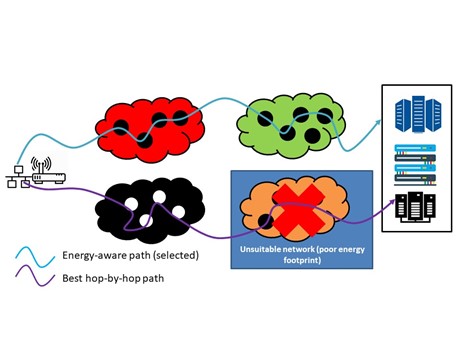
Figure 3: Energy-aware networking at the Internet scale.
The network can take care of battery-powered terminals too.
Likewise, IPv6 signaling traffic can be significantly reduced to preserve IPv6 terminals from too many, likely dispensable signaling messages. Mobile terminals may thus be able to process such messages while they are asleep. They can also rate-limit identical signaling messages, which are repeatedly sent. In addition, wake-up call procedures [RFC6059] can make sure that a terminal is dynamically detected upon network attachment, for the benefit of saving the energy stored in the terminal’s battery.
Measured energy consumption fuels energy-aware route computation logics.
The monitoring of energy-related information can assist energy-aware networking for the sake of optimized energy consumption. The Energy Management framework that has been documented in [RFC7326] is one example of an information model that is organized into Energy Objects (EO), where EOs can refer to energy consumers (routers, line cards, switches, etc.) or energy producers (power supply systems, battery cells, inverters, etc.).
Such framework can be applied to any kind of networking environment (home, cloud, core networks, to begin with). Two Management Information Bases (MIB) have also been documented to provide tools for describing the EO contexts as well as monitoring and control objects, for the sake of optimizing energy consumption within networks.
Conclusion
Energy-aware networking is no science fiction. There are already tools (protocols, data models, algorithmics) that can contribute to the achievement of significant energy savings, from terminals to networks, from networks to the cloud infrastructures, from telco cloud infrastructures to the global Internet.
Even though the design and the enforcement of energy-efficient traffic forwarding and routing policies are undeniably complex, many standards and prototype implementations illustrate the benefits of such approach not only for network operators but also to users.
Orange is no stranger to energy-aware networking. Besides the recognized expertise in energy-aware sensor networking acquired by the Group for about a decade (including an active contribution to the corresponding standardization effort conducted by the Internet Engineering Task Force (IETF, roll [roll] and lpwan [lpwan] working groups in particular) and the European Telecommunications Standards Institute (ETSI, oneM2M initiative [ONEM2M]), Orange conducts various initiatives to optimize the energy footprint of its networks, e.g., in regions of the world where the use of solar energy is instrumental [SOLAR].
Also, monitoring the energy consumed by network devices hosted in central offices or radio sites can fuel the design of energy-aware networking led Orange to conceive a “recommendation engine” that relies upon Artificial Intelligence techniques [SOFRECOM].
These are just a few examples of Orange’s expertise in energy-aware networking.
Now is definitely a good time to take full advantage of it.
Read more :
[ACKLIO2022] Acklio, “Cellular IoT Efficiency with SCHC”, 2022. Available at: https://www.ackl.io/solutions/cellular-iot-efficiency.
[CHABAREK2008] Chabarek, J., et al., “Power Awareness in Network Design and Routing”, 27th Conference on Computer Communications, April 2008. DOI: 10.1109/INFOCOM.2008.93
[CONTRACTID] Le Roux, J.-L., Jacob, R., Douville, R., “Carrying a Contract Identifier in PCE Communication Protocol (PCEP)”, draft-leroux-pce-contract-id-01, Work in Progress, March 2007.
[IEA2021] International Energy Agency (IEA), “Data Centres and Data Transmission Networks”, Paris, 2021. Available at: https://www.iea.org/reports/data-centres-and-data-transmission-networks.
[lpwan] https://datatracker.ietf.org/wg/lpwan/about/
[META2021] Facebook sustainability, “2020 Data Disclosures”, June 2021. Available at: https://sustainability.fb.com/wp-content/uploads/2021/06/2020_FB_Sustainability-Data.pdf.
[ONEM2M] https://www.etsi.org/committee/1419-onem2m
[RAMAN2013] Raman, S., Raina G., Srini, V., “Reducing Power Consumption using BGP path selection”, draft-mjsraman-panet-bgp-power-path, Work in Progress, March 2013.
[RFC6059] Krishnan, S., Daley, G., “Simple Procedures for Detecting Network Attachment in IPv6”, RFC 6059, November 2010.
[RFC6551] Vasseur, J.-P., Kim, M., et al., “Routing Metrics used for Path Calculation in Low Power and Lossy Networks”, RFC 6551, March 2012.
[RFC6552] Thubert, P., Ed., et al., “Objective Function Zero for the Routing Protocol for Low-Power and Lossy Networks (RPL)”, RFC 6552, March 2012.
[RFC7326] Parello, J., Claise, B., Schoening B., Quittek, J., “energy Management Framework”, RFC 7326, September 2014.
[RFC8402] Filsfils, C., Ed., Previdi, S., Ed., Decraene, B., Litkowski, S., Shakir, R., “Segment Routing Architecture”, RFC 8402, July 2018.
[roll] https://datatracker.ietf.org/wg/roll/about/
[RPL2014] Jacquenet, C., Ed., Wang, H., Zheng, T, Gu, D., “An IPv6 Routing Scheme for a Performant Internet of Things”, Orange Labs Research Paper, June 2014.
[SOLAR] https://www.orange.com/en/newsroom/news/2021/orange-major-player-solar-energy-mea







